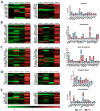The Impact of Spaceflight and Microgravity on the Human Islet-1+ Cardiovascular Progenitor Cell Transcriptome
- PMID: 33808224
- PMCID: PMC8036947
- DOI: 10.3390/ijms22073577
The Impact of Spaceflight and Microgravity on the Human Islet-1+ Cardiovascular Progenitor Cell Transcriptome
Abstract
Understanding the transcriptomic impact of microgravity and the spaceflight environment is relevant for future missions in space and microgravity-based applications designed to benefit life on Earth. Here, we investigated the transcriptome of adult and neonatal cardiovascular progenitors following culture aboard the International Space Station for 30 days and compared it to the transcriptome of clonally identical cells cultured on Earth. Cardiovascular progenitors acquire a gene expression profile representative of an early-stage, dedifferentiated, stem-like state, regardless of age. Signaling pathways that support cell proliferation and survival were induced by spaceflight along with transcripts related to cell cycle re-entry, cardiovascular development, and oxidative stress. These findings contribute new insight into the multifaceted influence of reduced gravitational environments.
Keywords: cardiovascular; miRNA; microgravity; proliferation; spaceflight; stemness; transcriptomics.
Conflict of interest statement
The authors declare no conflict of interest.
Figures






Similar articles
-
Leveraging Spaceflight to Advance Cardiovascular Research on Earth.Circ Res. 2022 Mar 18;130(6):942-957. doi: 10.1161/CIRCRESAHA.121.319843. Epub 2022 Mar 17. Circ Res. 2022. PMID: 35298305 Free PMC article. Review.
-
Effects of Spaceflight and Simulated Microgravity on YAP1 Expression in Cardiovascular Progenitors: Implications for Cell-Based Repair.Int J Mol Sci. 2019 Jun 4;20(11):2742. doi: 10.3390/ijms20112742. Int J Mol Sci. 2019. PMID: 31167392 Free PMC article.
-
Spaceflight Activates Protein Kinase C Alpha Signaling and Modifies the Developmental Stage of Human Neonatal Cardiovascular Progenitor Cells.Stem Cells Dev. 2018 Jun 15;27(12):805-818. doi: 10.1089/scd.2017.0263. Epub 2018 Feb 12. Stem Cells Dev. 2018. PMID: 29320953
-
Integrated spaceflight transcriptomic analyses and simulated space experiments reveal key molecular features and functional changes driven by space stressors in space-flown C. elegans.Life Sci Space Res (Amst). 2025 Feb;44:10-22. doi: 10.1016/j.lssr.2024.11.004. Epub 2024 Nov 22. Life Sci Space Res (Amst). 2025. PMID: 39864902
-
Transcriptomics, NF-κB Pathway, and Their Potential Spaceflight-Related Health Consequences.Int J Mol Sci. 2017 May 31;18(6):1166. doi: 10.3390/ijms18061166. Int J Mol Sci. 2017. PMID: 28561779 Free PMC article. Review.
Cited by
-
Omics Studies of Tumor Cells under Microgravity Conditions.Int J Mol Sci. 2024 Jan 11;25(2):926. doi: 10.3390/ijms25020926. Int J Mol Sci. 2024. PMID: 38255998 Free PMC article. Review.
-
Leveraging Spaceflight to Advance Cardiovascular Research on Earth.Circ Res. 2022 Mar 18;130(6):942-957. doi: 10.1161/CIRCRESAHA.121.319843. Epub 2022 Mar 17. Circ Res. 2022. PMID: 35298305 Free PMC article. Review.
-
Cardiovascular adaptations and pathological changes induced by spaceflight: from cellular mechanisms to organ-level impacts.Mil Med Res. 2024 Sep 27;11(1):68. doi: 10.1186/s40779-024-00570-3. Mil Med Res. 2024. PMID: 39334239 Free PMC article. Review.
-
Space Travel: The Radiation and Microgravity Effects on the Cardiovascular System.Int J Mol Sci. 2024 Nov 3;25(21):11812. doi: 10.3390/ijms252111812. Int J Mol Sci. 2024. PMID: 39519362 Free PMC article. Review.
-
Bioprinting of Cardiac Tissue in Space: Where Are We?Adv Healthc Mater. 2023 Sep;12(23):e2203338. doi: 10.1002/adhm.202203338. Epub 2023 Jun 14. Adv Healthc Mater. 2023. PMID: 37312654 Free PMC article.
References
MeSH terms
Substances
Grants and funding
LinkOut - more resources
Full Text Sources
Other Literature Sources

